Trends and Influencing Factors of Summer Air Quality Changes in Four Forest Types
Abstract
1. Introduction
2. Materials and Methods
2.1. Study Area
2.2. Observation Instruments
2.3. Data Processing and Analysis
2.3.1. Data Processing
2.3.2. Data Analysis
3. Results
3.1. The Changing Trends of Concentrations of Air Pollutants and NAI
3.2. The Relationship Between Forest Structure and Air Quality
3.3. The Impact of Environmental Factors on Air Quality
3.3.1. The Impact of Environmental Factors on Air Pollutants
3.3.2. The Impact of Environmental Factors on NAI
4. Discussion
4.1. Differences in Air Quality Among Different Forest Types
4.1.1. PM Concentration
4.1.2. Ozone Concentration
4.1.3. NAI Concentration
4.2. Factors Affecting Air Quality in Different Forest Types
4.2.1. The Impact of Plant Groups on Air Quality
4.2.2. The Impact of Forest Structure on Air Quality
4.2.3. Impact of Environmental Factors on Air Quality
4.3. Suggestions on Selecting Healthy Forest Stands and the Timing of Healthcare
5. Conclusions
Author Contributions
Funding
Data Availability Statement
Conflicts of Interest
Abbreviations
| PM | particulate matter |
| PM2.5 | fine particulate matter |
| PM10 | inhalable particulate matter |
| O3 | ozone |
| NAI | negative air ion |
| BVOCs | biogenic volatile organic compounds |
| EB | evergreen broad-leaved forests |
| MB | moso bamboo plantations |
| MCB | mixed coniferous and broad-leaved forests |
| DB | deciduous broad-leaved forests |
| TH | tree height |
| DBH | diameter at breast height |
| SD | stand density |
| SHD | shrub density |
| CHL | coverage of herb layer |
| CD | canopy density |
| SDS | Simpson diversity index of shrubs layer |
| SDH | Simpson diversity index of herbaceous Layer |
| SWS | Shannon–Wiener index of shrub layer |
| SWH | Shannon–Wiener index of herbaceous Layer |
| TA | air temperature |
| RH | relative humidity |
| WS | wind speed |
| LI | light intensity |
| CO2 | carbon dioxide |
References
- Liang, L.; Wang, Z.; Li, J. The effect of urbanization on environmental pollution in rapidly developing urban agglomerations. J. Clean. Prod. 2019, 237, 117649. [Google Scholar] [CrossRef]
- World Health Organization. WHO Global Air Quality Guidelines: Particulate Matter (PM2.5 and PM10), Ozone, Nitrogen Dioxide, Sulfur Dioxide and Carbon Monoxide; World Health Organization: Geneva, Switzerland, 2021. [Google Scholar]
- Reiter, R. Part B Frequency distribution of positive and negative small ion concentrations, based on many years’ recordings at two mountain stations located at 740 and 1780 m ASL. Int. J. Biometeorol. 1985, 29, 223–231. [Google Scholar] [CrossRef]
- Lu, X.; Lin, C.; Li, W.; Chen, Y.; Huang, Y.; Fung, J.C.; Lau, A.K. Analysis of the adverse health effects of PM2.5 from 2001 to 2017 in China and the role of urbanization in aggravating the health burden. Sci. Total Environ. 2019, 652, 683–695. [Google Scholar] [CrossRef]
- Mudway, I.; Kelly, F. Ozone and the lung: A sensitive issue. Mol. Asp. Med. 2000, 21, 1–48. [Google Scholar] [CrossRef] [PubMed]
- Krueger, A.P.; Reed, E.J. Biological Impact of Small Air Ions: Despite a history of contention, there is evidence that small air ions can affect life processes. Science 1976, 193, 1209–1213. [Google Scholar] [CrossRef]
- Chen, L.; Liu, C.; Zhang, L.; Zou, R.; Zhang, Z. Variation in tree species ability to capture and retain airborne fine particulate matter (PM2.5). Sci. Rep. 2017, 7, 3206. [Google Scholar] [CrossRef]
- Chen, L.; Sun, B.; Tan, G.; Li, Z.; Chen, Y.; Huang, Y.; Liao, S. Plant species structure and diversity of plant communities in Guangzhou parks. Ecol. Sci. 2015, 34, 38–44. [Google Scholar] [CrossRef]
- Chen, L.; Liu, C.; Zou, R.; Yang, M.; Zhang, Z. Experimental examination of effectiveness of vegetation as bio-filter of particulate matters in the urban environment. Environ. Pollut. 2016, 208, 198–208. [Google Scholar] [CrossRef]
- Cai, L.; Shi, G.; Zhang, J.; Du, L.; Ni, X.; Hu, Y.; Pang, D.; Meng, J. Empirical analysis of the influence mechanism of vegetation and environment on negative air ion in warm temperate forest ecosystems. Environ. Pollut. 2024, 363, 125273. [Google Scholar] [CrossRef]
- Ryu, J.; Kim, J.J.; Byeon, H.; Go, T.; Lee, S.J. Removal of fine particulate matter (PM2.5) via atmospheric humidity caused by evapotranspiration. Environ. Pollut. 2019, 245, 253–259. [Google Scholar] [CrossRef]
- Sæbø, A.; Popek, R.; Nawrot, B.; Hanslin, H.; Gawronska, H.; Gawronski, S. Plant species differences in particulate matter accumulation on leaf surfaces. Sci. Total Environ. 2012, 427, 347–354. [Google Scholar] [CrossRef] [PubMed]
- Hu, Y.; Zhao, P.; Niu, J.; Sun, Z.; Zhu, L.; Ni, G. Canopy stomatal uptake of NOX, SO2 and O3 by mature urban plantations based on sap flow measurement. Atmos. Environ. 2016, 125, 165–177. [Google Scholar] [CrossRef]
- Jeong, N.-R.; Han, S.-W.; Kim, J.-H. Evaluation of vegetation configuration models for managing particulate matter along the urban street environment. Forests 2022, 13, 46. [Google Scholar] [CrossRef]
- Zhu, C.; Przybysz, A.; Chen, Y.; Guo, H.; Chen, Y.; Zeng, Y. Effect of spatial heterogeneity of plant communities on air PM10 and PM2.5 in an urban forest park in Wuhan, China. Urban For. Urban Green. 2019, 46, 126487. [Google Scholar] [CrossRef]
- Liu, Y.; Li, L.; An, J.; Huang, L.; Yan, R.; Huang, C.; Wang, H.; Wang, Q.; Wang, M.; Zhang, W. Estimation of biogenic VOC emissions and its impact on ozone formation over the Yangtze River Delta region, China. Atmos. Environ. 2018, 186, 113–128. [Google Scholar] [CrossRef]
- Liu, S.; Huang, Q.; Wu, Y.; Song, Y.; Dong, W.; Chu, M.; Yang, D.; Zhang, X.; Zhang, J.; Chen, C. Metabolic linkages between indoor negative air ions, particulate matter and cardiorespiratory function: A randomized, double-blind crossover study among children. Environ. Int. 2020, 138, 105663. [Google Scholar] [CrossRef]
- Wang, H.; Wang, B.; Niu, X.; Song, Q.; Li, M.; Luo, Y.; Liang, L.; Du, P.; Peng, W. Study on the change of negative air ion concentration and its influencing factors at different spatio-temporal scales. Glob. Ecol. Conserv. 2020, 23, e01008. [Google Scholar] [CrossRef]
- Li, A.; Li, Q.; Yang, Y.; Hu, Y.; Xiao, S.; Li, Z.; Zhou, B. Stand structure and environment jointly determine negative air ion concentrations in forests: Evidence from concurrent on-site monitoring in four typical subtropical forests during the growing season. Environ. Exp. Bot. 2024, 220, 105684. [Google Scholar] [CrossRef]
- Kalivitis, N.; Stavroulas, I.; Bougiatioti, A.; Kouvarakis, G.; Gagné, S.; Manninen, H.; Kulmala, M.; Mihalopoulos, N. Night-time enhanced atmospheric ion concentrations in the marine boundary layer. Atmos. Chem. Phys. 2012, 12, 3627–3638. [Google Scholar] [CrossRef]
- Deng, C.; Zhang, S.; Lu, Y. Research on the Monitoring and Evaluation of Forest Function in Air Environmental Quality Improvement. Ecol. Environ. Sci. 2015, 24, 84–89. [Google Scholar] [CrossRef]
- Zhu, S.; Wang, R.; Wang, Q.; Lei, T.; Cui, G. Coniferous and broad-leaved mixed forest has the optimal forest therapy environment among stand types in Xinjiang. Ecol. Indic. 2024, 169, 112950. [Google Scholar] [CrossRef]
- Shi, G.-Y.; Zhou, Y.; Sang, Y.-Q.; Huang, H.; Zhang, J.-S.; Meng, P.; Cai, L.-L. Modeling the response of negative air ions to environmental factors using multiple linear regression and random forest. Ecol. Inform. 2021, 66, 101464. [Google Scholar] [CrossRef]
- Liu, C.; Dai, A.; Ji, Y.; Sheng, Q.; Zhu, Z. Effect of different plant communities on fine particle removal in an urban road greenbelt and its key factors in Nanjing, China. Sustainability 2022, 15, 156. [Google Scholar] [CrossRef]
- Li, S.; Li, A.; Shi, C.; Zhao, N.; Xu, X.; Zheng, L.; Guo, J.; Lu, S. Interactive Response Mechanism of Different Urban Forest Stands to Negative Air Ion and Ozone Concentration. J. Southwest For. Univ. (Nat. Sci.) 2023, 43, 74–80. [Google Scholar]
- Aydin, Y.M.; Yaman, B.; Koca, H.; Dasdemir, O.; Kara, M.; Altiok, H.; Dumanoglu, Y.; Bayram, A.; Tolunay, D.; Odabasi, M. Biogenic volatile organic compound (BVOC) emissions from forested areas in Turkey: Determination of specific emission rates for thirty-one tree species. Sci. Total Environ. 2014, 490, 239–253. [Google Scholar] [CrossRef]
- Guidolotti, G.; Pallozzi, E.; Gavrichkova, O.; Scartazza, A.; Mattioni, M.; Loreto, F.; Calfapietra, C. Emission of constitutive isoprene, induced monoterpenes, and other volatiles under high temperatures in Eucalyptus camaldulensis: A 13C labelling study. Plant Cell Environ. 2019, 42, 1929–1938. [Google Scholar] [CrossRef]
- Wu, K.; Yang, X.; Chen, D.; Gu, S.; Lu, Y.; Jiang, Q.; Wang, K.; Ou, Y.; Qian, Y.; Shao, P. Estimation of biogenic VOC emissions and their corresponding impact on ozone and secondary organic aerosol formation in China. Atmos. Res. 2020, 231, 104656. [Google Scholar] [CrossRef]
- Li, N.; He, Q.; Greenberg, J.; Guenther, A.; Li, J.; Cao, J.; Wang, J.; Liao, H.; Wang, Q.; Zhang, Q. Impacts of biogenic and anthropogenic emissions on summertime ozone formation in the Guanzhong Basin, China. Atmos. Chem. Phys. 2018, 18, 7489–7507. [Google Scholar] [CrossRef]
- Fitzky, A.C.; Sandén, H.; Karl, T.; Fares, S.; Calfapietra, C.; Grote, R.; Saunier, A.; Rewald, B. The interplay between ozone and urban vegetation—BVOC emissions, ozone deposition, and tree ecophysiology. Front. For. Glob. Change 2019, 2, 50. [Google Scholar] [CrossRef]
- Wang, Y.; Liu, F.; Zhou, X.; Liu, X.; Li, L. Air Anions Content and Its Evaluation for Main Forest Types in Chongqing. J. Northeast. For. Univ. 2014, 42, 38–42. [Google Scholar] [CrossRef]
- Kousis, I.; Manni, M.; Pisello, A. Environmental mobile monitoring of urban microclimates: A review. Renew. Sustain. Energy Rev. 2022, 169, 112847. [Google Scholar] [CrossRef]
- Jeanjean, A.P.; Monks, P.S.; Leigh, R.J. Modelling the effectiveness of urban trees and grass on PM2.5 reduction via dispersion and deposition at a city scale. Atmos. Environ. 2016, 147, 1–10. [Google Scholar] [CrossRef]
- Popek, R.; Przybysz, A.; Gawrońska, H.; Klamkowski, K.; Gawroński, S.W. Impact of particulate matter accumulation on the photosynthetic apparatus of roadside woody plants growing in the urban conditions. Ecotoxicol. Environ. Saf. 2018, 163, 56–62. [Google Scholar] [CrossRef]
- Viippola, V.; Whitlow, T.H.; Zhao, W.; Yli-Pelkonen, V.; Mikola, J.; Pouyat, R.; Setälä, H. The effects of trees on air pollutant levels in peri-urban near-road environments. Urban For. Urban Green. 2018, 30, 62–71. [Google Scholar] [CrossRef]
- Yin, S.; Chen, D.; Zhang, X.; Yan, J. Review on the multi-scale interactions of urban forests and atmospheric particles: Affecting factors are scale-dependent among tree, stand and region. Urban For. Urban Green. 2022, 78, 127789. [Google Scholar] [CrossRef]
- Przybysz, A.; Nersisyan, G.; Gawroński, S.W. Removal of particulate matter and trace elements from ambient air by urban greenery in the winter season. Environ. Sci. Pollut. Res. 2019, 26, 473–482. [Google Scholar] [CrossRef] [PubMed]
- Shao, F.; Wang, L.; Sun, F.; Li, G.; Yu, L.; Wang, Y.; Zeng, X.; Yan, H.; Dong, L.; Bao, Z. Study on different particulate matter retention capacities of the leaf surfaces of eight common garden plants in Hangzhou, China. Sci. Total Environ. 2019, 652, 939–951. [Google Scholar] [CrossRef]
- Baraldi, R.; Neri, L.; Costa, F.; Facini, O.; Rapparini, F.; Carriero, G. Ecophysiological and micromorphological characterization of green roof vegetation for urban mitigation. Urban For. Urban Green. 2019, 37, 24–32. [Google Scholar] [CrossRef]
- Weerakkody, U.; Dover, J.W.; Mitchell, P.; Reiling, K. Evaluating the impact of individual leaf traits on atmospheric particulate matter accumulation using natural and synthetic leaves. Urban For. Urban Green. 2018, 30, 98–107. [Google Scholar] [CrossRef]
- Zhai, H.; Yao, J.; Wang, G.; Tang, X. Study of the effect of vegetation on reducing atmospheric pollution particles. Remote Sens. 2022, 14, 1255. [Google Scholar] [CrossRef]
- Janhäll, S. Review on urban vegetation and particle air pollution–Deposition and dispersion. Atmos. Environ. 2015, 105, 130–137. [Google Scholar] [CrossRef]
- Su, T.-H.; Lin, C.-S.; Lu, S.-Y.; Lin, J.-C.; Wang, H.-H.; Liu, C.-P. Effect of air quality improvement by urban parks on mitigating PM2.5 and its associated heavy metals: A mobile-monitoring field study. J. Environ. Manag. 2022, 323, 116283. [Google Scholar] [CrossRef] [PubMed]
- Abhijith, K.; Kumar, P.; Gallagher, J.; McNabola, A.; Baldauf, R.; Pilla, F.; Broderick, B.; Di Sabatino, S.; Pulvirenti, B. Air pollution abatement performances of green infrastructure in open road and built-up street canyon environments—A review. Atmos. Environ. 2017, 162, 71–86. [Google Scholar] [CrossRef]
- Deshmukh, P.; Isakov, V.; Venkatram, A.; Yang, B.; Zhang, K.M.; Logan, R.; Baldauf, R. The effects of roadside vegetation characteristics on local, near-road air quality. Air Qual. Atmos. Health 2019, 12, 259–270. [Google Scholar] [CrossRef]
- Kwak, M.J.; Lee, J.; Kim, H.; Park, S.; Lim, Y.; Kim, J.E.; Baek, S.G.; Seo, S.M.; Kim, K.N.; Woo, S.Y. The removal efficiencies of several temperate tree species at adsorbing airborne particulate matter in urban forests and roadsides. Forests 2019, 10, 960. [Google Scholar] [CrossRef]
- Yli-Pelkonen, V.; Scott, A.A.; Viippola, V.; Setälä, H. Trees in urban parks and forests reduce O3, but not NO2 concentrations in Baltimore, MD, USA. Atmos. Environ. 2017, 167, 73–80. [Google Scholar] [CrossRef]
- Liu, K.; Li, J.; Sun, L.; Yang, X.; Xu, C.; Yan, G. Impact of Urban Forest and Park on Air Quality and the Microclimate in Jinan, Northern China. Atmosphere 2024, 15, 426. [Google Scholar] [CrossRef]
- Ram, S.; Majumder, S.; Chaudhuri, P.; Chanda, S.; Santra, S.; Chakraborty, A.; Sudarshan, M. A review on air pollution monitoring and management using plants with special reference to foliar dust adsorption and physiological stress responses. Crit. Rev. Environ. Sci. Technol. 2015, 45, 2489–2522. [Google Scholar] [CrossRef]
- Schilperoort, B.; Coenders-Gerrits, M.; Rodríguez, C.J.; van Hooft, A.; van de Wiel, B.; Savenije, H. Detecting nighttime inversions in the interior of a Douglas fir canopy. Agric. For. Meteorol. 2022, 321, 108960. [Google Scholar] [CrossRef]
- Miao, S.; Zhang, X.; Han, Y.; Sun, W.; Liu, C.; Yin, S. Random forest algorithm for the relationship between negative air ions and environmental factors in an urban park. Atmosphere 2018, 9, 463. [Google Scholar] [CrossRef]
- Li, A.; Li, Q.; Zhou, B.; Ge, X.; Cao, Y. Temporal dynamics of negative air ion concentration and its relationship with environmental factors: Results from long-term on-site monitoring. Sci. Total Environ. 2022, 832, 155057. [Google Scholar] [CrossRef] [PubMed]
- Zhu, C.; Ji, P.; Li, S. Effects of urban green belts on the air temperature, humidity and air quality. J. Environ. Eng. Landsc. Manag. 2017, 25, 39–55. [Google Scholar] [CrossRef]
- Han, J.; Liu, X.; Chen, D.; Jiang, M. Influence of relative humidity on real-time measurements of particulate matter concentration via light scattering. J. Aerosol Sci. 2020, 139, 105462. [Google Scholar] [CrossRef]
- Jayamurugan, R.; Kumaravel, B.; Palanivelraja, S.; Chockalingam, M. Influence of temperature, relative humidity and seasonal variability on ambient air quality in a coastal urban area. Int. J. Atmos. Sci. 2013, 2013, 264046. [Google Scholar] [CrossRef]
- Burch, A.Y.; Zeisler, V.; Yokota, K.; Schreiber, L.; Lindow, S.E. The hygroscopic biosurfactant syringafactin produced by P seudomonas syringae enhances fitness on leaf surfaces during fluctuating humidity. Environ. Microbiol. 2014, 16, 2086–2098. [Google Scholar] [CrossRef]
- Shi, G.; Sang, Y.; Zhang, J.; Meng, P.; Cai, L.; Pei, S. Relationship between Negative Air Ion and Relative Humidity in Quercus variabilis Plantation under Natural Conditions. Chin. J. Agrometeorol. 2021, 42, 24–33. [Google Scholar]
- Horrak, U.; Salm, J.; Tammet, H. Bursts of intermediate ions in atmospheric air. J. Geophys. Res. Atmos. 1998, 103, 13909–13915. [Google Scholar] [CrossRef]
- Wu, Y.; Ma, W.; Liu, J.; Zhu, L.; Cong, L.; Zhai, J.; Wang, Y.; Zhang, Z. Sabina chinensis and Liriodendron chinense improve air quality in Beijing, China. PLoS ONE 2018, 13, e0189640. [Google Scholar] [CrossRef]
- Deng, S.; Ma, J.; Zhang, L.; Jia, Z.; Ma, L. Microclimate simulation and model optimization of the effect of roadway green space on atmospheric particulate matter. Environ. Pollut. 2019, 246, 932–944. [Google Scholar] [CrossRef]
- Jiang, S.-Y.; Ma, A.; Ramachandran, S. Negative air ions and their effects on human health and air quality improvement. Int. J. Mol. Sci. 2018, 19, 2966. [Google Scholar] [CrossRef]
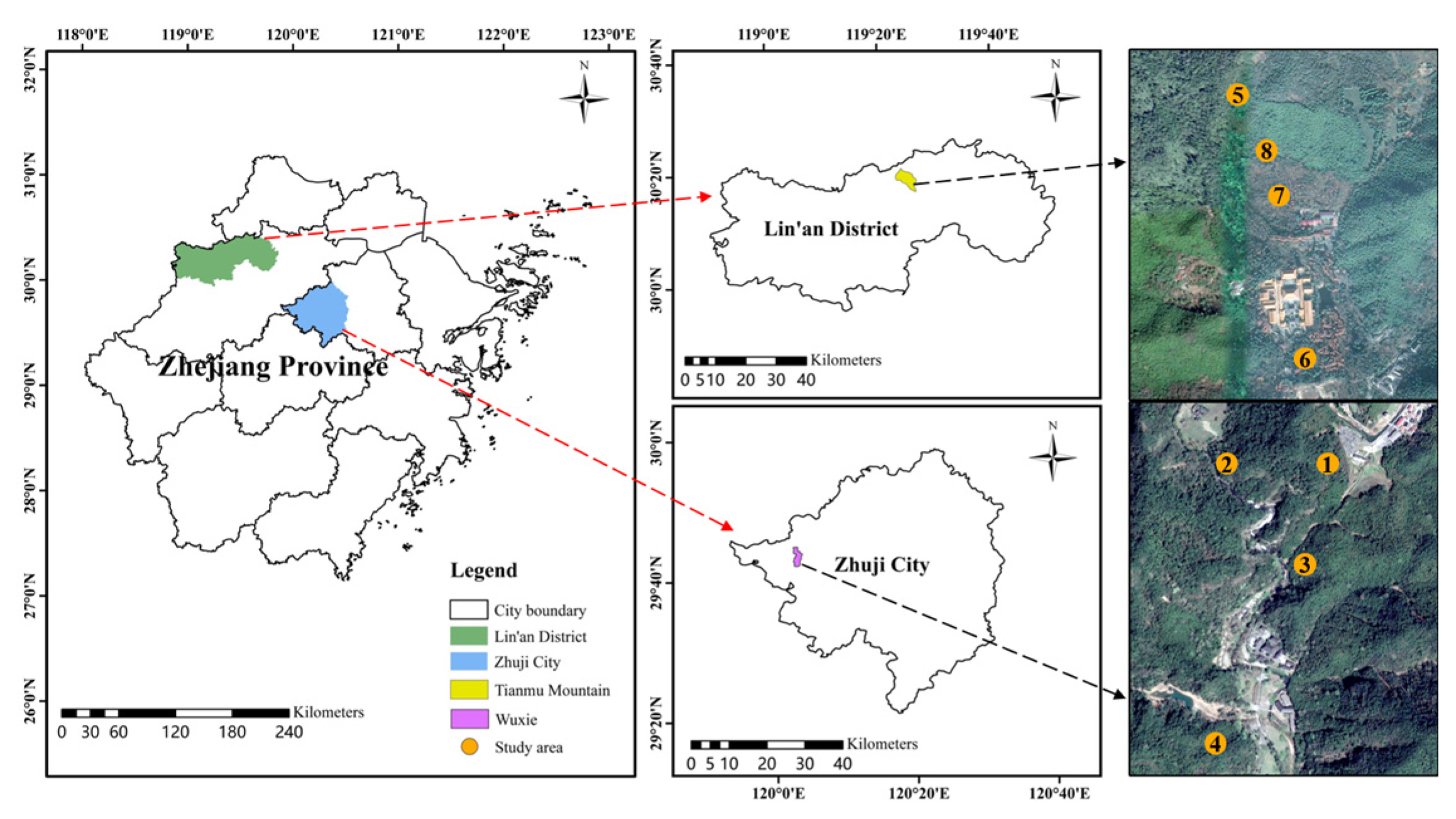

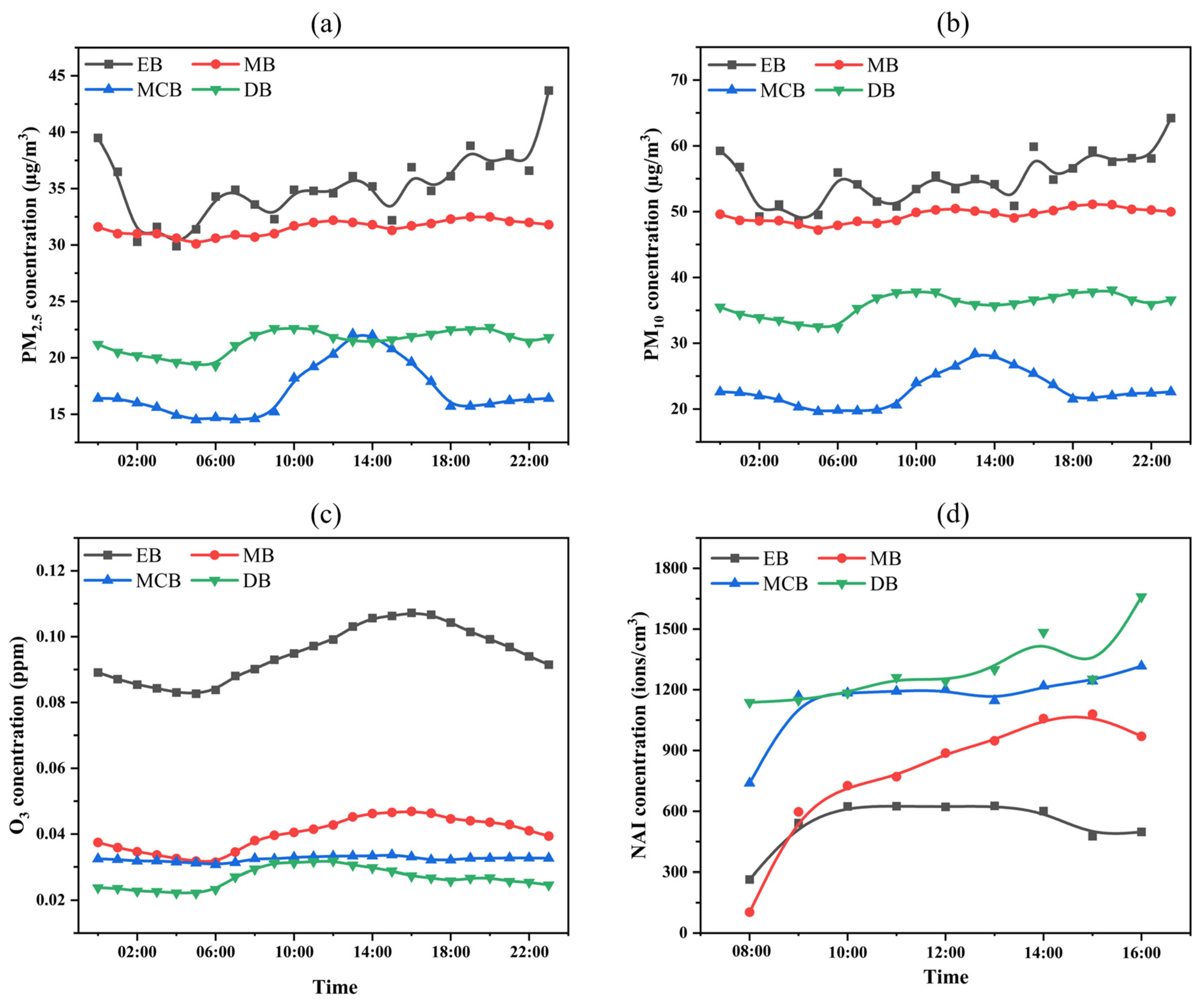
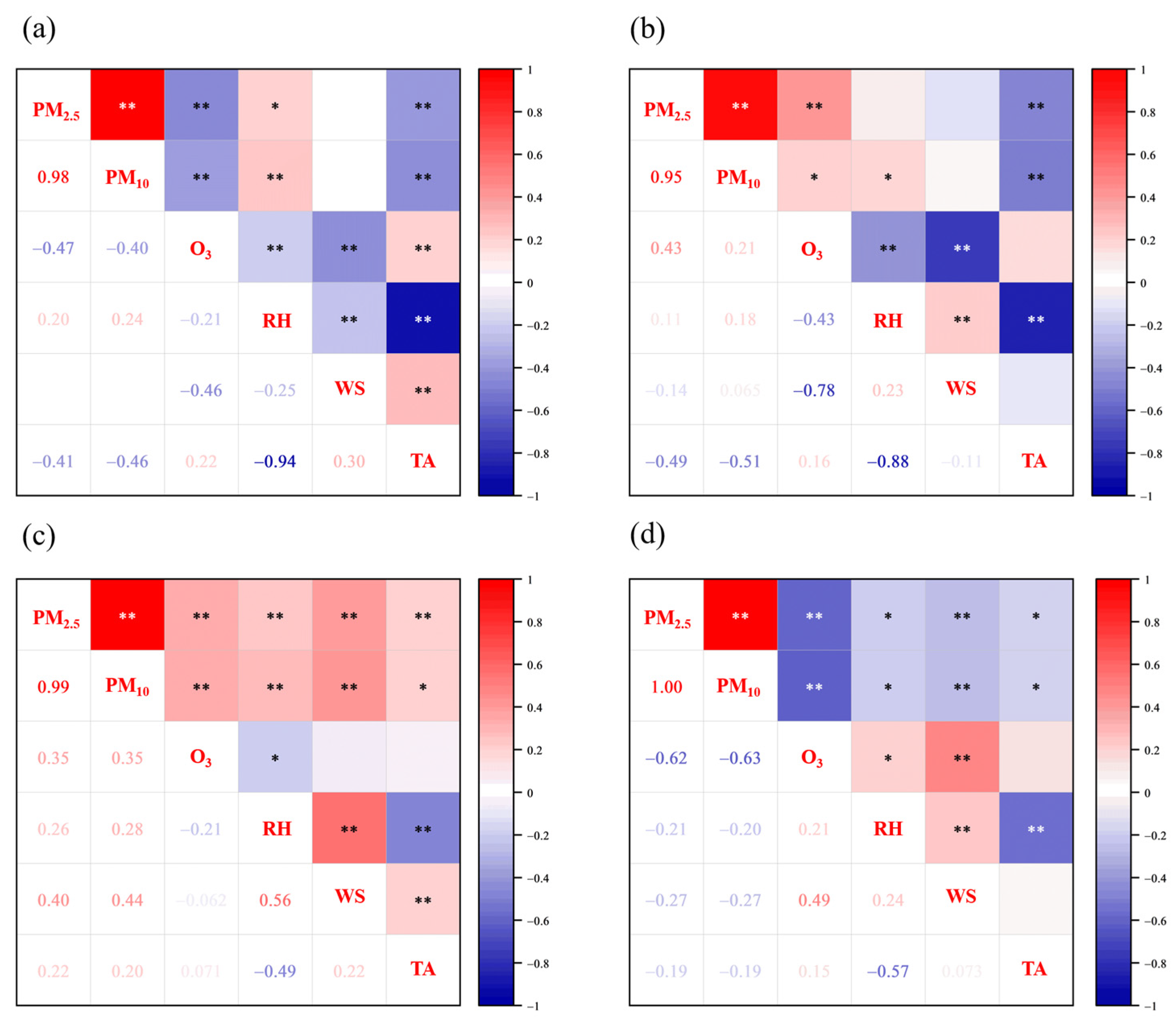

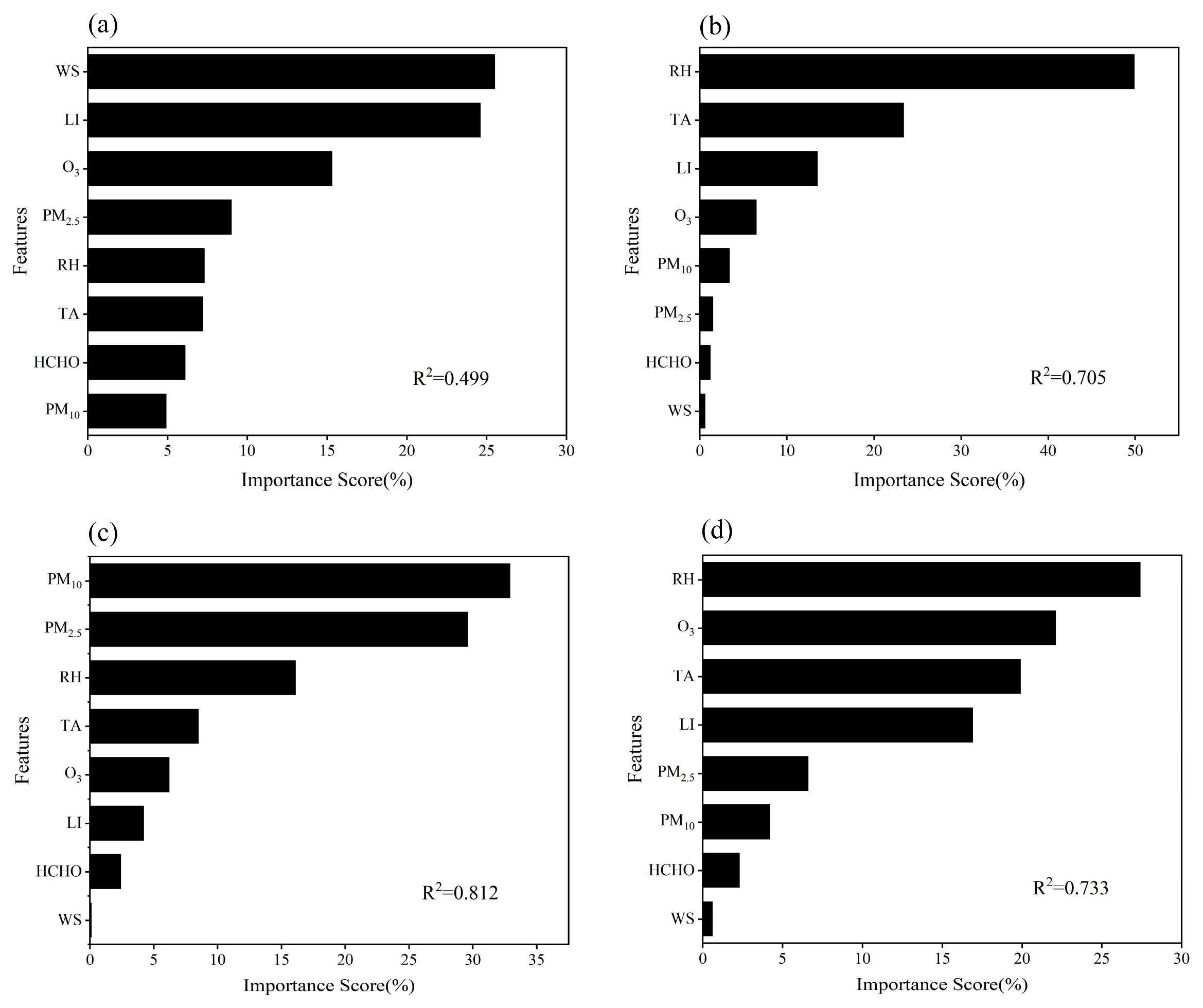
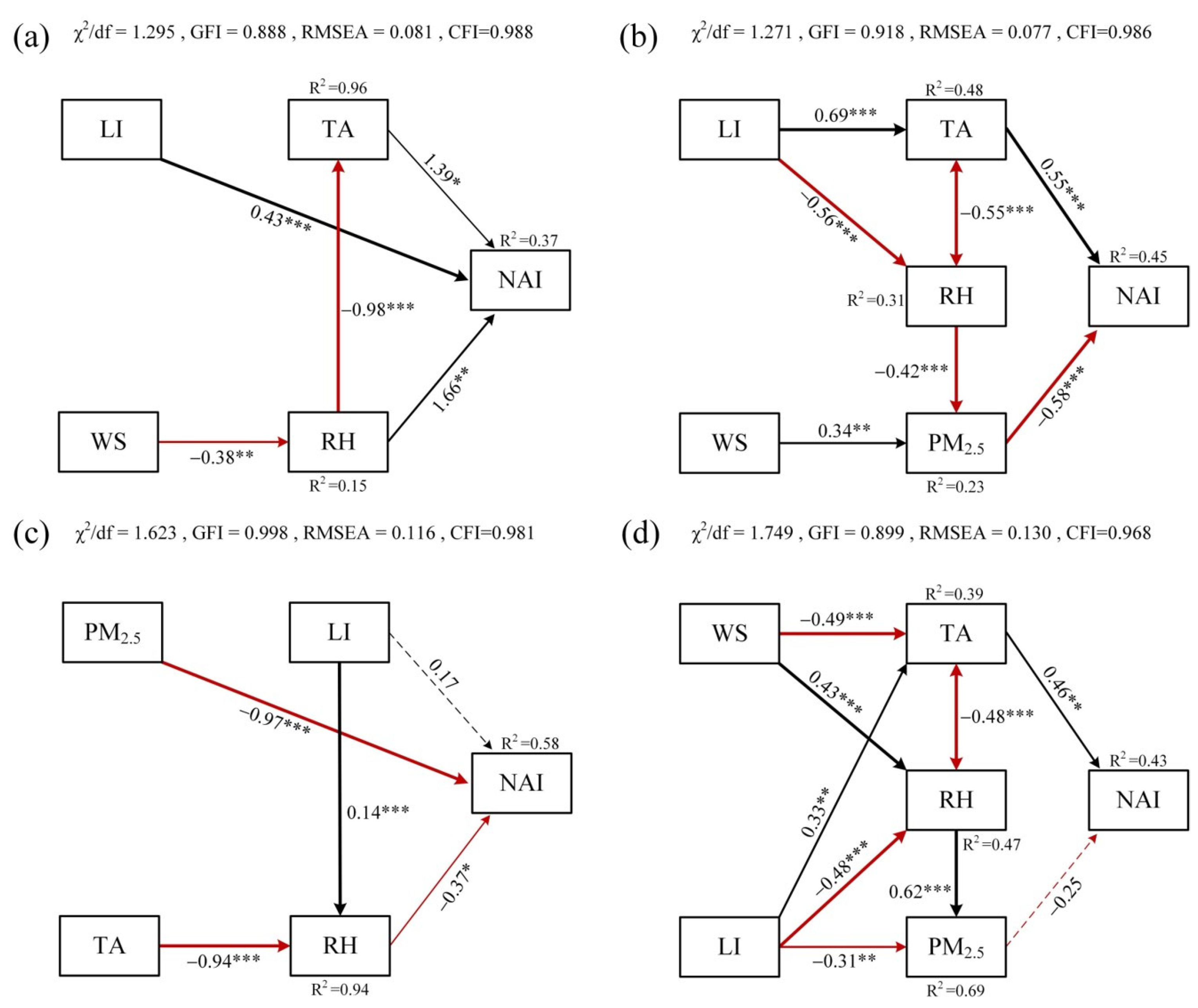
| Forest Type | Number | Gradient (°) | Slope Orientation | Altitude (m) | Longitude | Latitude |
|---|---|---|---|---|---|---|
| EB | 1 | 21.7 | West | 271.5 | 29°44′24″ | 120°2′56″ |
| 2 | 11.2 | Northeast | 276.0 | 29°44′24″ | 120°2′46″ | |
| MB | 3 | 27.7 | Southeast | 202.9 | 29°44′13″ | 120°2′52″ |
| 4 | 18.6 | Southwest | 198.6 | 29°43′55″ | 120°2′46″ | |
| MCB | 5 | 6.2 | Southeast | 469.9 | 30°19′46″ | 119°26′28″ |
| 6 | 3.6 | Northeast | 365.1 | 30°19′19″ | 119°26′35″ | |
| DB | 7 | 33.0 | West | 392.6 | 30°19′35″ | 119°26′32″ |
| 8 | 21.5 | Northwest | 452.7 | 30°19′41″ | 119°26′30″ |
| Number | Dominant Species | Average TH (m) | Average DBH (cm) | SD (plants/ha) | SHD (plants/ha) | CHL (%) | CD | SDS | SDH | SWS | SWH |
|---|---|---|---|---|---|---|---|---|---|---|---|
| 1 | Schima superba Gardner & Champ. | 14.71 | 28.35 | 350 | 35,000 | 4.0 | 0.85 | 0.765 | 0.431 | 1.593 | 0.727 |
| 2 | Schima superba Gardner & Champ. | 9.45 | 16.07 | 850 | 11,666 | 33.7 | 0.85 | 0.857 | 0.654 | 2.069 | 1.279 |
| 3 | Phyllostachys edulis (Carrière) J. Houzeau | 11.25 | 11.99 | 4150 | 30,000 | 42.9 | 0.80 | 0.559 | 0.774 | 0.983 | 1.682 |
| 4 | Phyllostachys edulis (Carrière) J. Houzeau | 12.01 | 12.51 | 3575 | 15,833 | 31.3 | 0.90 | 0.853 | 0.773 | 2.156 | 1.740 |
| 5 | Cryptomeria japonica var. sinensis Miquel, Ginkgo biloba L. | 18.46 | 24.07 | 925 | 9167 | 47.8 | 0.86 | 0.893 | 0.770 | 2.272 | 1.851 |
| 6 | Cryptomeria japonica var. sinensis Miquel, Bischofia polycarpa (Levl.) Airy—Shaw | 16.95 | 49.28 | 150 | 3750 | 71.3 | 0.85 | 0.444 | 0.805 | 0.637 | 1.917 |
| 7 | Quercus acutissima Carruth., Liquidambar formosana Hance | 12.46 | 20.12 | 850 | 35,833 | 18.3 | 0.84 | 0.609 | 0.828 | 1.463 | 1.965 |
| 8 | Liquidambar formosana Hance, Quercus acutissima Carruth. | 12.19 | 18.06 | 950 | 38,333 | 28.7 | 0.81 | 0.661 | 0.737 | 1.304 | 1.590 |
| Factors | Data Sensors | Unit | Measuring Accuracy | Resolution Ratio |
|---|---|---|---|---|
| PM2.5 | SDS011 | 0–1000 μg/m3 | <±10 μg/m3 + 10% | 1 µg/m3 |
| PM10 | SDS011 | 0–1000 μg/m3 | <±10 μg/m3 + 10% | 1 µg/m3 |
| O3 | QT4S | 0–1 ppm | <±0.5% | 0.001 ppm |
| TA | SHT21 | −20–85 °C | ±0.5 | 0.1 °C |
| RH | SHT21 | 0%–100% RH | ±3% | 0.10% |
| WS | HQC-FS1 | 0–30 m/s | ±0.3 | 0.1 m/s |
| LI | BH1750FVI | 0–200 klux | ±2% | 0.01 klux |
| CO2 | CRIR M1 | 400–2000 ppm | ±40 ppm ± 3% | 1 ppm |
| NAI | WST-10D | 1–5 million ions/cm3 | ±5% | 1 ions/cm3 |
| HCHO | WST-10D | 0–10 mg/m3 | ±5% | 0.01 mg/m3 |
| Model | R2 | |
|---|---|---|
| PM2.5 | Y = 24.956 + 4.285 *(x1) − 6.986 **(x2) | 0.751 |
| PM10 | Y = 38.144 + 9.064 **(x1) − 12.081 **(x2) | 0.923 |
| O3 | Y = 0.035 − 0.004 *(x3) + 0.007 **(x4) | 0.851 |
| NAI | Y = 987.25 + 459.823(x3) − 446.014(x5) | 0.405 |
| Air Pollutants | Forest Type | Multiple Regression Equation | R2 | p |
|---|---|---|---|---|
| PM2.5 | EB | Y = 436.062 − 2.391 *** × RH − 7.491 *** × TA + 29.263 * × WS | 0.451 | 0.001 |
| MB | Y = 386.672 − 2.188 *** × RH − 6.19 *** × TA − 0.038 × WS | 0.745 | 0.001 | |
| MCB | Y = 125.937 − 1.179 ** × RH − 0.152 × TA + 474.775 *** × WS | 0.256 | 0.001 | |
| DB | Y = 98.828 − 0.574 *** × RH − 1.095 *** × TA − 29.801 × WS | 0.165 | 0.001 | |
| PM10 | EB | Y = 753.213 − 4.173 *** × RH − 12.943 *** × TA + 31.12 * × WS | 0.601 | 0.001 |
| MB | Y = 604.067 − 3.404 *** × RH − 9.756 *** × TA + 0.443 * × WS | 0.716 | 0.001 | |
| MCB | Y = 159.917 − 1.423 ** × RH − 0.595 × TA + 786.884 *** × WS | 0.292 | 0.001 | |
| DB | Y = 176.498 − 1.054 *** × RH − 1.931 *** × TA − 69.401 × WS | 0.175 | 0.001 | |
| O3 | EB | Y = −463.089 + 2.521*** × RH + 10.023 *** × TA − 154.132 *** × WS | 0.536 | 0.001 |
| MB | Y = 0.358 − 0.002 *** × RH − 0.004 *** × TA − 0.002 *** × WS | 0.670 | 0.001 | |
| MCB | Y = 0.127 − 0.001 *** × RH − 0.001 *** × TA + 0.173 *** × WS | 0.167 | 0.001 | |
| DB | Y = 30.685 + 0.059 × RH − 1.356 × TA + 532.236 *** × WS | 0.129 | 0.001 |
Disclaimer/Publisher’s Note: The statements, opinions and data contained in all publications are solely those of the individual author(s) and contributor(s) and not of MDPI and/or the editor(s). MDPI and/or the editor(s) disclaim responsibility for any injury to people or property resulting from any ideas, methods, instructions or products referred to in the content. |
© 2025 by the authors. Licensee MDPI, Basel, Switzerland. This article is an open access article distributed under the terms and conditions of the Creative Commons Attribution (CC BY) license (https://creativecommons.org/licenses/by/4.0/).
Share and Cite
Jia, Z.; Zhou, R.; Jiao, J.; Pan, C.; Chen, Z.; Huang, Y.; Zhou, Y.; Zhou, G. Trends and Influencing Factors of Summer Air Quality Changes in Four Forest Types. Forests 2025, 16, 833. https://doi.org/10.3390/f16050833
Jia Z, Zhou R, Jiao J, Pan C, Chen Z, Huang Y, Zhou Y, Zhou G. Trends and Influencing Factors of Summer Air Quality Changes in Four Forest Types. Forests. 2025; 16(5):833. https://doi.org/10.3390/f16050833
Chicago/Turabian StyleJia, Zichen, Ruyi Zhou, Jiejie Jiao, Chunyu Pan, Zhihao Chen, Yichen Huang, Yufeng Zhou, and Guomo Zhou. 2025. "Trends and Influencing Factors of Summer Air Quality Changes in Four Forest Types" Forests 16, no. 5: 833. https://doi.org/10.3390/f16050833
APA StyleJia, Z., Zhou, R., Jiao, J., Pan, C., Chen, Z., Huang, Y., Zhou, Y., & Zhou, G. (2025). Trends and Influencing Factors of Summer Air Quality Changes in Four Forest Types. Forests, 16(5), 833. https://doi.org/10.3390/f16050833







